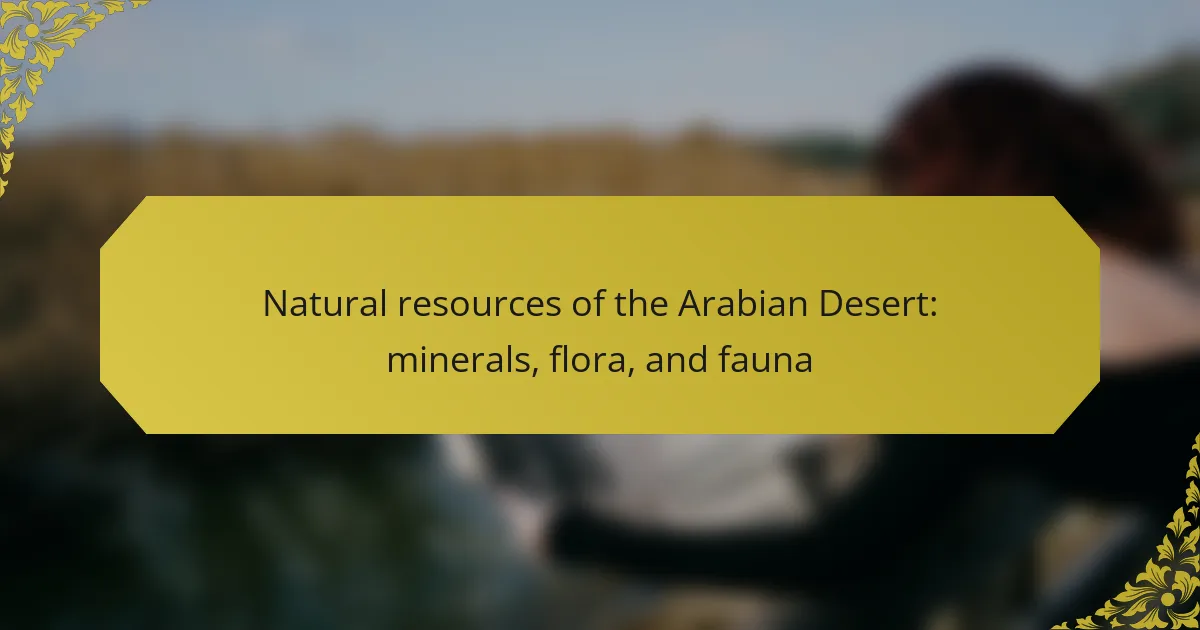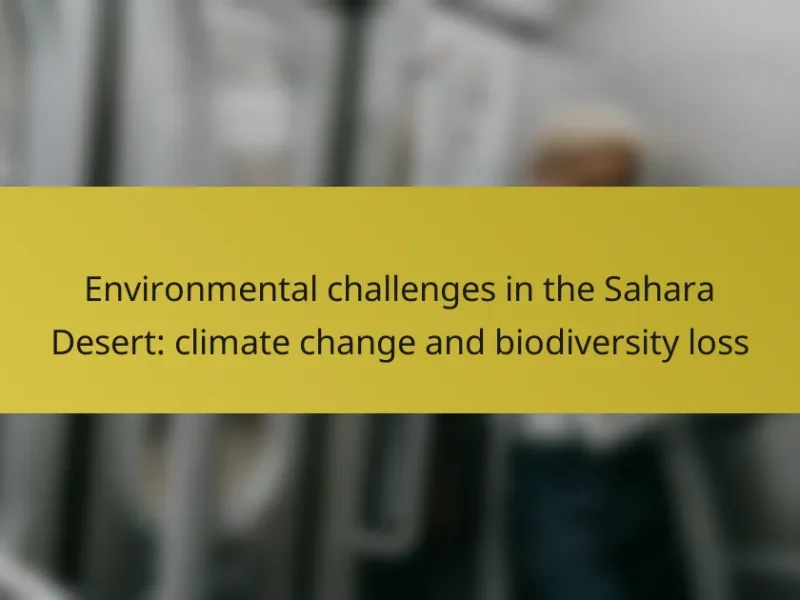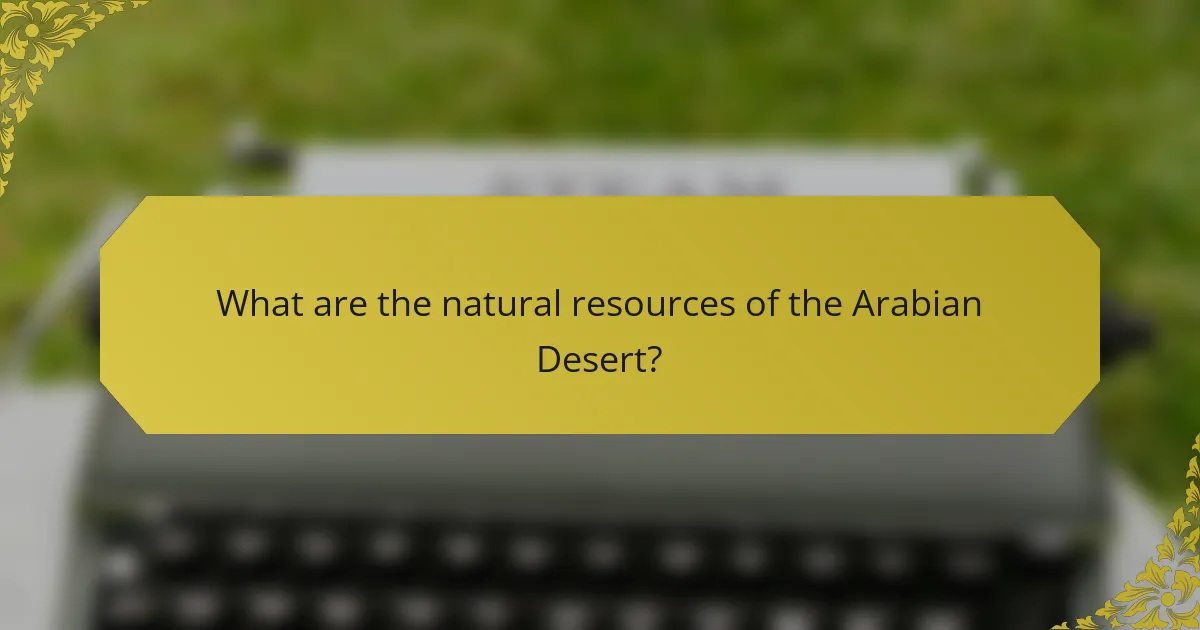
What are the natural resources of the Arabian Desert?
The natural resources of the Arabian Desert include oil, natural gas, minerals, and unique flora and fauna. Oil reserves are extensive, making the Arabian Peninsula one of the largest oil-producing regions globally. Natural gas is also abundant, supporting energy needs and export. Mineral resources include gypsum, limestone, and salt, which are used in construction and industry. The desert is home to various plant species adapted to arid conditions, such as date palms and acacia trees. Additionally, wildlife includes species like the Arabian oryx and sand gazelle, which are adapted to the harsh environment. These resources are vital for the economy and biodiversity of the region.
How do minerals contribute to the ecosystem of the Arabian Desert?
Minerals contribute to the ecosystem of the Arabian Desert by providing essential nutrients for plant growth. These minerals, found in the soil, support the limited vegetation that thrives in harsh conditions. Key minerals include potassium, phosphorus, and nitrogen. They play a crucial role in photosynthesis and overall plant health. The presence of these minerals affects soil fertility and structure. Healthy plants, in turn, support herbivores and other wildlife. This interdependence sustains the delicate food web in the desert ecosystem. Studies show that mineral-rich areas often have higher biodiversity. Thus, minerals are vital for maintaining ecological balance in the Arabian Desert.
What types of minerals are found in the Arabian Desert?
The Arabian Desert contains various types of minerals. Common minerals found include gypsum, salt, and limestone. Additionally, the region has deposits of phosphates and sulfur. Minerals like copper and iron ore are also present in certain areas. The mineral wealth supports local industries and contributes to the economy. Geological surveys confirm these mineral types in the Arabian Desert.
How are these minerals extracted and utilized?
Minerals in the Arabian Desert are extracted primarily through mining operations. These operations include surface mining, underground mining, and quarrying. Surface mining is used for minerals located near the surface, such as gypsum and limestone. Underground mining is employed for deeper minerals like copper and gold. Quarrying is often used for extracting stone and gravel.
Utilization of these minerals varies by type. Gypsum is used in construction for drywall and cement production. Limestone serves as a base material in road construction and as a chemical feedstock. Copper is essential in electrical wiring and electronics. Gold is utilized in jewelry and as an investment asset.
The extraction process involves several stages. First, geological surveys identify mineral deposits. Then, extraction methods are selected based on the mineral type and location. Finally, the extracted minerals undergo processing to remove impurities and prepare them for market. These steps ensure that the minerals are efficiently utilized in various industries.
What role does flora play in the Arabian Desert’s environment?
Flora plays a crucial role in the Arabian Desert’s environment by providing essential habitat and food sources. Various plant species, such as acacia and date palms, stabilize the soil and prevent erosion. These plants help maintain moisture levels in the arid climate. Flora also contributes to the local ecosystem by supporting diverse wildlife. Pollinators, such as bees, rely on flowering plants for sustenance. Additionally, vegetation helps regulate temperatures by providing shade. The roots of desert plants improve soil structure and fertility. Overall, flora is vital for sustaining life in the harsh desert environment.
Which plant species are endemic to the Arabian Desert?
The plant species endemic to the Arabian Desert include the Acacia tortilis and the Prosopis cineraria. Acacia tortilis, commonly known as the umbrella thorn acacia, is well adapted to arid conditions. It provides shade and food for local wildlife. Prosopis cineraria, also known as the ghaf tree, is crucial for desert ecosystems. This tree is drought-resistant and can survive in harsh climates. Both species demonstrate unique adaptations to their environment. Their presence highlights the biodiversity of the Arabian Desert.
How do these plants adapt to extreme conditions?
Plants in extreme conditions, such as those in the Arabian Desert, adapt through various mechanisms. They employ water conservation strategies like deep root systems to access underground water. Some plants have thick, waxy leaves to reduce water loss. Others possess specialized structures, such as spines, to minimize surface area and discourage herbivores. Additionally, many plants enter a dormant state during extreme heat or drought. They may also utilize photosynthesis adaptations, such as [censured] (Crassulacean Acid Metabolism), to optimize water use. These adaptations enable survival in harsh environments with limited resources.
How does fauna inhabit the Arabian Desert?
Fauna inhabits the Arabian Desert through various adaptations. Many species have evolved to survive extreme temperatures and scarce water. For example, the Arabian oryx can go long periods without drinking. It obtains moisture from the plants it eats. Nocturnal behavior is common among desert animals to avoid daytime heat. Species like the sand fox are active at night. Burrowing is another adaptation; animals like the desert hare dig to escape heat. Some fauna have specialized kidneys to conserve water. These adaptations enable diverse species to thrive in harsh conditions.
What animal species are native to the Arabian Desert?
The Arabian Desert is home to several native animal species. Notable species include the Arabian Oryx, which is adapted to arid conditions. The sand gazelle is another species that thrives in this environment. The desert also hosts the Arabian wolf, a smaller subspecies of the gray wolf. Additionally, the Arabian leopard resides in mountainous regions of the desert. Reptiles such as the horned viper are common, showcasing the desert’s biodiversity. These species have adapted to the harsh climate and limited water availability. Their presence is crucial to the desert ecosystem.
How do these animals survive in such a harsh climate?
Animals in harsh climates, like the Arabian Desert, survive through various adaptations. They have evolved to conserve water and regulate body temperature. Many desert animals are nocturnal, avoiding extreme daytime heat. They often have specialized kidneys that excrete concentrated urine to minimize water loss. Some species, like camels, store fat in their humps, which can be metabolized for energy and water. Additionally, many have light-colored fur to reflect sunlight. These adaptations enable them to thrive in environments with scarce resources and extreme temperatures.
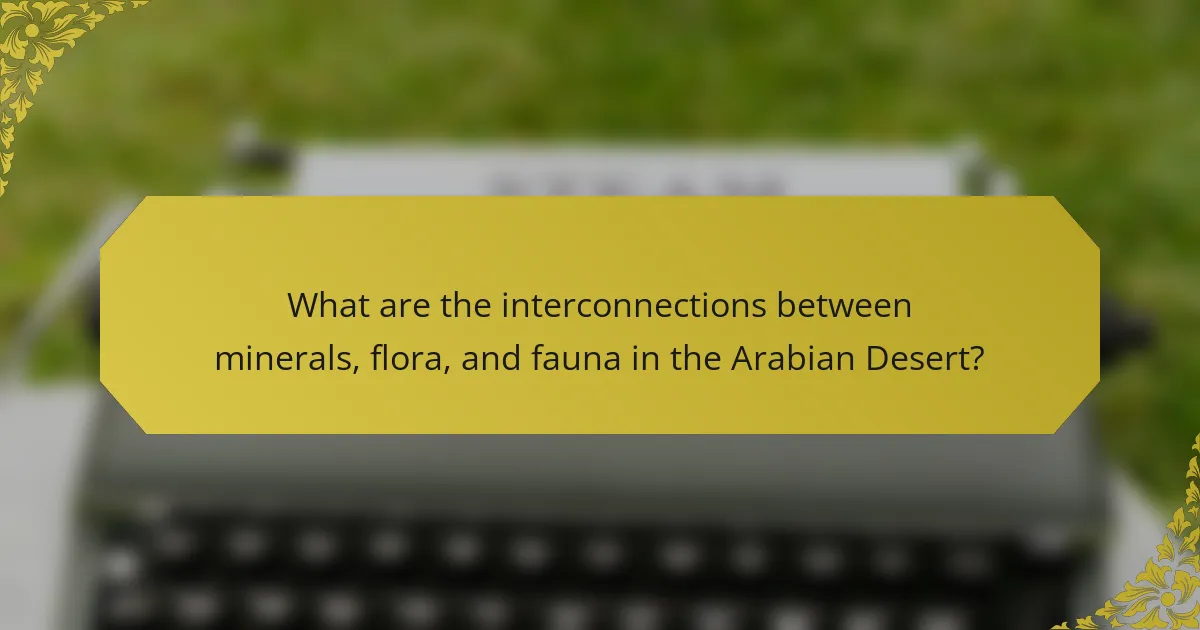
What are the interconnections between minerals, flora, and fauna in the Arabian Desert?
Minerals, flora, and fauna in the Arabian Desert are interdependent. Minerals provide essential nutrients for plant growth. Flora, such as acacia trees, stabilize the soil and prevent erosion. In turn, plants offer food and habitat for various animal species. Fauna, including rodents and birds, help disperse seeds, promoting plant reproduction. The nutrient cycle is critical for maintaining ecosystem balance. For example, the presence of phosphates in the soil enhances vegetation health. Healthy flora supports diverse fauna, creating a thriving ecosystem. This interconnectedness is vital for the desert’s ecological stability.
How do minerals affect the growth of flora in the Arabian Desert?
Minerals significantly influence the growth of flora in the Arabian Desert. Essential nutrients like nitrogen, phosphorus, and potassium are vital for plant development. These minerals support processes such as photosynthesis and root growth. In arid environments, mineral availability can limit plant diversity and productivity. Soil composition in the Arabian Desert varies, affecting mineral content. Some areas have higher mineral concentrations, promoting richer vegetation. Additionally, minerals can enhance drought resistance in certain plant species. Research indicates that mineral-rich soils correlate with increased flora density in the region.
In what ways do flora and fauna interact within the ecosystem?
Flora and fauna interact within the ecosystem through various relationships such as mutualism, competition, and predation. Mutualism occurs when both plants and animals benefit from the interaction. For example, pollinators like bees help plants reproduce while receiving nectar as food. Competition arises when flora and fauna vie for the same resources, such as light, water, or nutrients. This can affect population dynamics and species distribution. Predation involves animals relying on plants for habitat while consuming other animals for food. These interactions contribute to ecosystem stability and biodiversity. In the Arabian Desert, specific plant adaptations allow them to thrive, supporting various animal species that depend on them for survival.
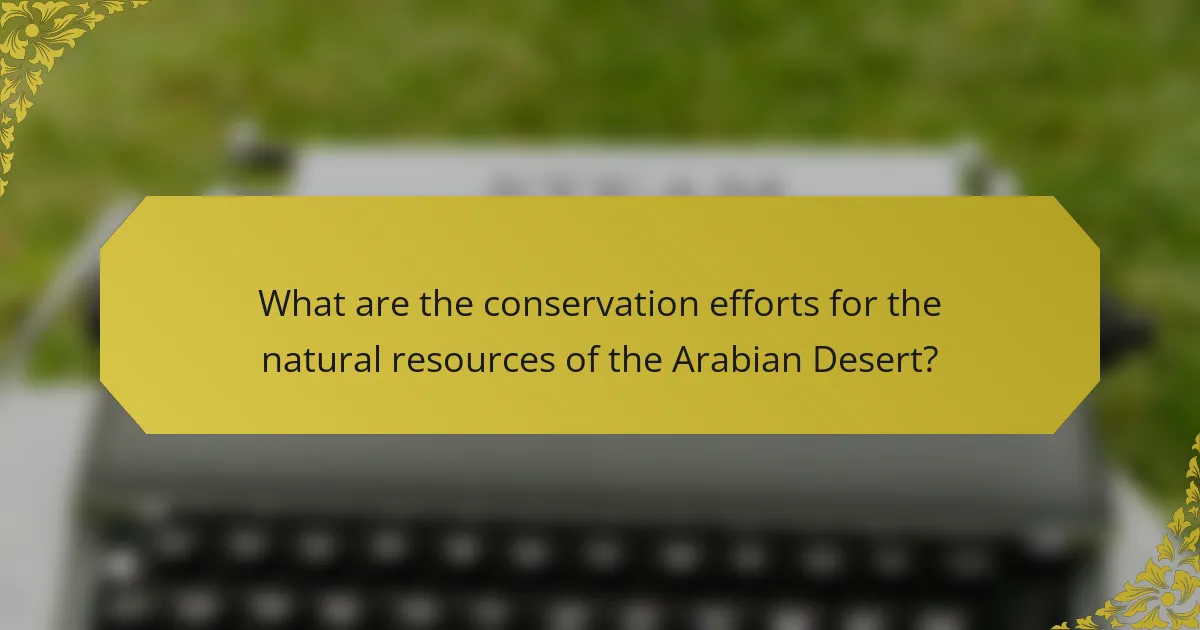
What are the conservation efforts for the natural resources of the Arabian Desert?
Conservation efforts for the natural resources of the Arabian Desert include habitat protection, sustainable land management, and reforestation initiatives. Various organizations work to establish protected areas to conserve biodiversity. The Saudi Wildlife Authority has implemented programs to protect endangered species. These programs focus on species like the Arabian Oryx and the Arabian Leopard. Additionally, efforts to combat desertification are in place, promoting sustainable agricultural practices. Research indicates that these practices help preserve soil quality and water resources. Community involvement is also encouraged to raise awareness about conservation. Educational programs aim to inform local populations about the importance of preserving their natural heritage.
What challenges do natural resources in the Arabian Desert face?
Natural resources in the Arabian Desert face significant challenges. Water scarcity is a primary issue due to low rainfall and high evaporation rates. This limits the availability of freshwater for both plants and animals. Soil degradation occurs from overgrazing and desertification, which diminishes arable land. Additionally, mining activities can lead to habitat destruction and pollution. Climate change exacerbates these problems by altering weather patterns and increasing temperatures. These factors threaten biodiversity and the sustainability of natural resources.
How do climate change and human activity impact these resources?
Climate change and human activity significantly impact the natural resources of the Arabian Desert, including minerals, flora, and fauna. Rising temperatures and changing precipitation patterns affect plant growth and biodiversity. For example, increased heat can lead to desertification, reducing the availability of flora. Human activities, such as overgrazing and urbanization, further strain these resources. These practices can lead to habitat loss for various species. Additionally, mining operations disrupt the ecosystem and deplete mineral resources. The combined effects of climate change and human actions threaten the sustainability of these vital resources.
What strategies are being implemented for sustainable management?
Sustainable management strategies for the Arabian Desert’s natural resources include conservation practices and community engagement. Conservation practices involve protecting habitats and species through designated reserves. Community engagement fosters local stewardship of resources, ensuring sustainable use. Education programs raise awareness about the importance of biodiversity. Research initiatives monitor ecosystem health and inform management decisions. Collaborative efforts with local tribes enhance traditional knowledge integration. Policy frameworks support sustainable resource utilization, balancing economic needs with environmental protection. These strategies collectively aim to preserve the desert’s unique minerals, flora, and fauna for future generations.
How can local communities contribute to conservation efforts?
Local communities can contribute to conservation efforts by engaging in sustainable practices and habitat restoration. They can implement community-led initiatives to protect local flora and fauna. Education programs can raise awareness about the importance of biodiversity. Local knowledge can inform conservation strategies that are culturally relevant. Collaborations with conservation organizations can enhance resource management. Involving community members in monitoring wildlife can provide valuable data. Research shows that local stewardship leads to better conservation outcomes. For example, the Arabian Oryx Reintroduction Program involved local communities in habitat protection, resulting in population recovery.
What practical steps can individuals take to support the natural resources of the Arabian Desert?
Individuals can support the natural resources of the Arabian Desert by practicing sustainable water usage. Conserving water helps maintain the delicate balance of the desert ecosystem. Implementing rainwater harvesting systems can significantly reduce water wastage. Additionally, using native plants in landscaping reduces the need for irrigation.
Promoting responsible tourism is another practical step. Tourists should follow designated paths to minimize soil erosion and protect native flora. Educating others about the importance of the desert’s biodiversity fosters greater awareness and conservation efforts.
Participating in local conservation projects can also make a difference. Many organizations focus on reforestation and habitat restoration. Supporting these initiatives can help restore degraded areas.
Finally, reducing plastic waste is crucial. Plastics can harm wildlife and disrupt natural habitats. Opting for reusable products minimizes environmental impact. Each of these actions contributes to the preservation of the Arabian Desert’s natural resources.
The primary entity of this article is the natural resources of the Arabian Desert, encompassing minerals, flora, and fauna. The article details the extensive oil and natural gas reserves, various minerals such as gypsum and limestone, and the unique plant and animal species adapted to the desert environment. It examines the interconnections between these resources, highlighting the role of minerals in supporting plant growth and the importance of flora in sustaining wildlife. Additionally, the article addresses conservation efforts, challenges posed by climate change and human activity, and practical steps individuals can take to contribute to the preservation of the Arabian Desert’s natural resources.
